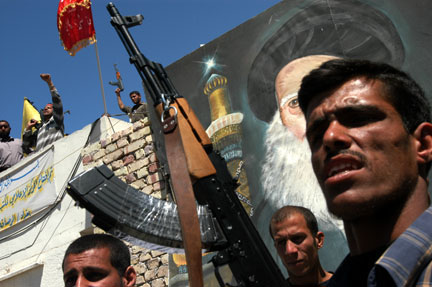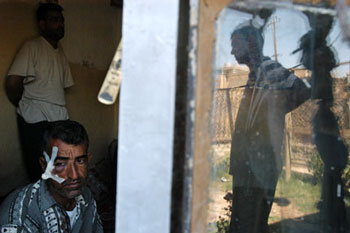Car bombs targeting hotels that housed foreign contractors were exploding occasionally in Baghdad, but as I prepared my fourth trip to Iraq the general situation in the country seemed to have settled into a tenuous routine. Aside from the periodic explosive events, Iraq had dropped into the background of international news coverage. I was looking forward to seeing how life had progressed for Iraqis one year after the war. Had daily life improved since the last time I was there in the chaotic wake of the coalition's invasion of the country? Would there be any sense on the ground of a political process to prepare for the transfer of sovereignty on June 30th? Even with clearly enormous hurdles still to overcome in Iraq, were people beginning to benefit from a modicum of liberty? I was glad that the situation was relatively stable, as I wanted to work on feature stories that would compliment the body of work I have been building over the past three years.
Then, on the day that I was speeding across 12 hours of desert between Amman, Jordan and Baghdad in a GMC Suburban, four American security contractors were killed and barbarically mutilated in the streets of Falluja, the hotbed of resistance to the occupation in the so-called Sunni Triangle.
From the minute I arrived in Baghdad, my preconceptions of the trip went straight out the window and I plunged into news mode.
Driving through the city, Baghdad looked largely the same - congested roads, semi-destroyed and burned out buildings and piles of garbage made it apparent that public services had not yet been restored. However, shops were open and there was much more activity than there had been last summer. The city had come back to life. One of the first things I noticed was that Iraqi policemen were everywhere, directing traffic, manning check points and driving around in brand new police SUVs.
 |
AFTERMATH: "MARTYRED" AL-SADR SUPPORTER Photo by J.B. Russell/Panos |
I checked into the hotel where many independent journalists, photographers and documentary filmmakers stay and requested a room with a south facing balcony for a clear shot at the Thuraya satellite for my Bgan modem and my Thuraya telephone. As I set up the equipment for filing pictures and communications, I discovered that my Thuraya SIM card had inexplicably been deactivated since the last time I had used it. In light of the events in Falluja, I imagined dozens of editors in agencies and magazines scattered across the US and Europe trying to reach me and not being able to get through. I turned on my French cell phone to change the time (I use it as an alarm clock) and was shocked to see that it had a signal. I knew that there was a cell network in Baghdad now, but I never imagined that my phone would work on it. At least I was reachable until I could get a local cell number and my Thuraya SIM card replaced. I also discovered, less surprisingly, that internet cafés were as numerous as the TV satellite dishes that sprouted from every rooftop and balcony around the city. Some things had indeed changed.
Falluja was rapidly surrounded by US forces, and fighting between insurgents and Marines quickly ensued. The Americans sealed off the city and no access was permitted to journalists who weren't embedded with the Marines. Many journalists trying to work in the area were detained by heavily armed, paranoid "resistance fighters," threatening them with execution, accusing them of being spies and checking all of their equipment and documents. Almost simultaneously, various groups kidnapped foreigners around the country and a young, radical Shiite cleric, Moktada al-Sadr, unleashed his personal militia, the Mehdi Army, to wreck havoc in the Shia areas of Baghdad and southern Iraq.
 |
MEHDI ARMY MILITIAMEN Photo by J.B. Russell/Panos |
Everything was unraveling and it was becoming extremely difficult and dangerous to work. I decided to focus on the al-Sadr uprising as this was a new development. If a generalized Shia uprising began to take hold in the country in addition to the established Sunni resistance to the occupation, this would constitute a serious deterioration of the situation. The impoverished Shia neighborhood of Sadr City in Baghdad, the flash point of the al-Sadr uprising, was still somewhat accessible.
Moktada al-Sadr is the 31 year old son of a highly respected Shia Ayatollah who was arrested and killed by Saddam Hussein along with several other members of his family. Moktada himself does not have a large following among Iraqi Shiites, but his radical, firebrand version of Islam and his calls for the immediate departure of coalition forces from Iraq appeal to the younger and most marginalized segments of the Shia community. His followers were enraged when the coalition closed down his organization's mouthpiece newspaper, al-Hawza, for inciting violence and arrested one of his senior aides. With tensions running high over Falluja, his defiance and violent attacks against the occupation had, in the eyes of some, gained him added credence as a courageous resistance fighter. However, he remained alienated from the majority Shiite population and leadership.
 |
AFTER THE SHELLING, SADR CITY Photo by J.B. Russell/Panos |
I left my passport and everything that might identify me as an American at the hotel and set off with my all-in-one driver, fixer, bodyguard and friend, Ziyad. American tanks sat on the outskirts of the vast Sadr City slum, where over 2 million Shiites live, blocking the principal
accesses to the area. We found a way in through a side street, creeping through a labyrinth of narrow, twisting alleys with open sewers. Once past the American cordon, we talked our way through several improvised check points manned by armed men wearing al-Sadr badges.
Ziyad, without me telling him to, presented me as a French journalist and this seemed to get us through. We eventually arrived at the headquarters of the al-Sadr organization where there was a large crowd of supporters and gunmen - members of the Mehdi Army. The situation was tense and the gunmen were suspicious of foreign journalists, but with a bit of time and negotiating by Ziyad, I was able to enter the building and work. This became our routine over the next week as I photographed gunmen taking up positions, preparing for the fight and crowds coming out to denounce the occupation. As the days passed I saw the aftermath of nightly clashes with the US forces, homes of innocent civilians that the locals said were targeted by American tanks and helicopters, and the funeral processions of the martyrs who were killed overnight. Eventually, the al-Sadr office itself was hit by tank shells and helicopter-fired guided missiles.
Things rapidly spiraled downward around the country. More and more people were killed, foreigners were being kidnapped daily, an Italian captive was executed, female journalists never went out without an all-covering hajab, male journalists began cultivating their beards and the roads out of the country were closed. Leaders on all sides apparently realized that this was all heading rapidly to an anarchic war and somehow someone managed to pull the emergency break, albeit only slightly.
A ceasefire in Falluja is regularly punctured by serious firefights, but negotiators are searching for a solution. Moktada al-Sadr is holed up in a mosque in Najaf, Shia Muslim's holiest city, surrounded by coalition forces whose mission is to capture or kill him. New kidnappings seem to have dropped off, but numerous captives are still being held. Violence continues to flare up, but an extremely fragile standoff has settled over the country.
The date for the handover of sovereignty is getting closer, temperatures are rising, the hotel filled up the pool and we're all waiting to see what happens next. Stay tuned...
© J.B. Russell
J.B. Russell is a Paris-based photojournalist. His work appears in major magazines around the world and has been recognized by several international awards. He is represented by the Panos, Cosmos, Grazia Neri and Cover agencies.

